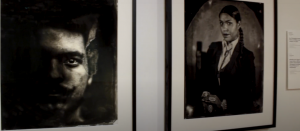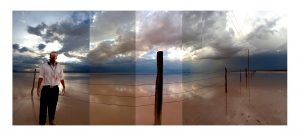Lara Abdelal
Introduction:
The work of Will Wilson focuses on using digital technology to express the Navajo people and their relation to the land. Wilson captures various environmental themes through his photographs and expresses them from an Indigenous perspective. During his career, he created a body of work called Auto Immune Response (AIR) that brings awareness to the destruction of the traditional Navajo environment and culture by contemporary society. Wilson and his work have been praised for being able to use contemporary art practices to bring awareness to indigenous peoples’ struggle with the land and toxic environment and for being able to combine his native culture with contemporary art forms to represent indigenous people in the contemporary world.
Theme:
The two main themes I will be addressing are how photography can promote environmental awareness and change in a contemporary setting and how the lack of true indigenous sovereignty promotes negative environmental factors, which pose a threat to indigenous people and their culture every day. In summary, I will be addressing photography of indigenous culture in relation to the environment.
Will Wilson’s work primarily focuses on addressing the impacts of cultural and environmental change on indigenous peoples and the possibility of cultural survival and renewal. He has spent many years combining technology with indigenous art practices in order to expand what is considered to be contemporary photography and inspire future generations. He prides himself on using Indigenous photography to inspire a new vision of whom Native people are instead of assimilating to typical contemporary photography. His art projects, including his Auto Immune Response series, are centered around indigenous peoples’ fight against a “toxic environment” which includes physical environmental factors, as well as historical factors.

Analysis: Will Wilson is a unique photographer that utilizes a historic wet plate collodion process (pictured above) along with modern techniques to create unique and meaningful photographs. He combines traditional and non-traditional art forms. His photography promotes indigenous cultural practices and incorporates them into contemporary art to raise awareness of the environmental issues affecting indigenous people. He combines contemporary and historic photographic processes to highlight environmental activism and promote change. The historic destruction of the Native American environment prompted Wilson to utilize this technique to introduce indigenous culture and technique into the contemporary art world in hopes to promote change in the future.

Analysis: Wilson is part of the Scientists/Artists Research Collaborations (SARC), which is a collaboration between artists who utilize science and technology in their art practice. In 2012, he started the Critical Indigenous Photographic Exchange (CIPX), where he collaborated with other artists to create portraits of Indigenous artists, educators, and community environmental activists using an early photographic wet plate process, which integrates indigenous culture and art into the modern world, to spark conversation about the negative impacts of cultural and environmental change on Indigenous peoples. Some of these photographs are displayed at the Denison Museum (pictured above).

Analysis: Since 2005, Wilson has been creating the “Auto Immune Response” series, to highlight the quixotic relationship between indigenous people and the beautiful, but toxic environment they inhabit. His series brings awareness to the destruction of the Indigenous lifestyle as a result of contemporary environmental contamination and destruction, the diseases it has caused, and how to survive and reconnect with the earth. Pictured above is one of the many photos in his series. The historical colonialization of indigenous land/culture may have also influenced the production of this series.
Application:
Will Wilson’s work encourages people to experience Native American culture in a new way by incorporating it into contemporary art. He has spread awareness of the environmental factors that put indigenous people in danger by utilizing unconventional photography practices and creating a series of art dedicated to them and their struggles. In the past, Native Americans have had to deal with various challenges relating to their culture. For decades, they have been forced to abandon their reservations, environmental practices, and culture. Will Wilson’s work proves to the rest of the world that indigenous culture has a place in the contemporary world. Through his photography, he has shown that contemporary art practices can be combined with indigenous practices to create something beautiful and educating.
Wilson encourages young artists to use their cultural identity in their work instead of assimilating to typical contemporary practices. His art contradicts conventional depictions of Native people that confine them to a fixed past. He has utilized his unconventional photography practices to raise awareness of the environmental factors that affect indigenous people in the contemporary world and advocate for change. He hopes that the advocation for survival and renewal of indigenous culture in the modern world will slow down the increased cases of cancer and autoimmune diseases, destruction of ancestral land, the continued history of “slow violence” against indigenous people, etc.
Will Wilson has dedicated his life to photography and using it to emphasize Native culture and its relationship to the environment. He wants to let others know that Indigenous culture can be part of the modern world and utilizes this contemporary representation to bring awareness to the environmental issues indigenous people face every day.
Media Attributions
- 9035623939_232896fb63_o
- Screen Shot 2022-04-27 at 6.20.21 PM
- 1365634755_3393eaf2fb_o

